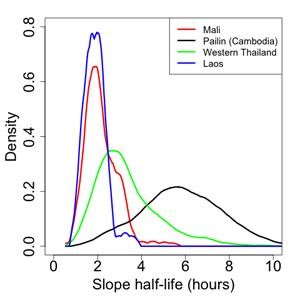Parasite clearance estimator (PCE)

Consistent, reliable and accurate method to estimate malaria parasite clearance, allowing detection of emerging drug resistance and efficacy evaluation of new anti-malaria drugs and therapies.
Anti-malarial testing
The parasite clearance estimator (PCE) represents a key component of the toolkit developed by the World Wide Anti-malarial Resistance Network. WWARN comprises a global network of experts supported by the Bill and Melinda Gates foundation and managed by the University of Oxford.
The PCE online tool provides a consistent, reliable and accurate method for measuring malaria parasite clearance based on the linear portion of the slope of the log-parasitaemia versus time relationship.
This standardised approach facilitates routine monitoring of artemisinin combination therapy (ACT) efficacy and allows comparisons over time and space.
Such information is critical to enable the detection of early changes in Plasmodium falciparum sensitivity to artemisinins and supports timely responses in treatment guidelines when needed.
It is also being used to support an FDA application for a novel anti-malarial drug.
Parasite clearance rate – an early indicator of anti-malarial resistance
The emergence and spread of resistance to antimalarial drugs threatens the efficacy of existing drug treatments. Parasite clearance rate is an important measure of drug efficacy.
The rate can be used to:
-
assess in vivo responses to treatment with artemisinin derivatives
-
evaluate new antimalarial drugs
-
assess therapeutic response in severe malaria and hyperparasitaemia
Emergent artemisinin resistance in Western Cambodia was first signalled by a significant reduction in parasite clearance rates following artesunate treatment of falciparum malaria. Resistance subsequently manifested in increased failure rates following ACT.
A uniform method to describe the delayed clearance phenotype is an essential research tool when assessing antimalarial efficacy data for signs of change. Only by comparison with baseline parasite clearance rates can prolonged clearance, an important early warning sign of resistance, be identified. To address this need, WWARN teams developed the PCE online tool.

Comparison of the estimated density function of slope half-lives (t1/2) between populations at different locations.
Request more information if you would like to discuss this further.
about this technology

